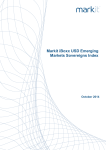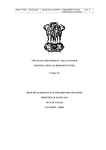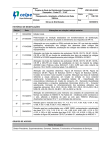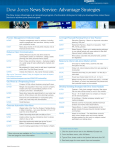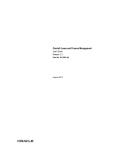Download User Guide
Transcript
Markit iBoxx SGD Bond Index Rules October 2014 Markit iBoxx SGD Bond Index Contents 1 2 3 4 5 Overview ............................................................................................................................................................... 4 1.1 Index family structure ...................................................................................................................................... 4 1.2 iBoxx Asian Oversight Committee .................................................................................................................. 5 1.3 Publication of the Markit iBoxx SGD Bond Index ........................................................................................... 5 Bond Selection Rules .......................................................................................................................................... 6 2.1 Bond selection ................................................................................................................................................ 6 2.1.1 Issuer type .............................................................................................................................................. 6 2.1.2 Bond type ................................................................................................................................................ 6 2.1.3 Credit Rating ........................................................................................................................................... 7 2.1.4 Time to maturity ...................................................................................................................................... 7 2.1.5 Amount outstanding and denomination .................................................................................................. 8 Bond classification .............................................................................................................................................. 9 3.1 Singapore Government Securities .................................................................................................................. 9 3.2 Sovereigns ...................................................................................................................................................... 9 3.3 Sub-sovereigns ............................................................................................................................................... 9 3.4 Corporates .................................................................................................................................................... 10 3.5 Additional Classifications .............................................................................................................................. 11 3.6 Classification Review Procedure .................................................................................................................. 11 Index Calculation ............................................................................................................................................... 12 4.1 Static data ..................................................................................................................................................... 12 4.2 Weighting ...................................................................................................................................................... 12 4.3 Bond prices ................................................................................................................................................... 12 4.4 Rebalancing process .................................................................................................................................... 12 4.5 Index data ..................................................................................................................................................... 12 4.6 Index calculus ............................................................................................................................................... 13 4.7 Treatment of the special intra-month events ................................................................................................ 13 4.7.1 Index and analytics weightings ............................................................................................................. 13 4.7.2 Scheduled partial redemptions: sinking funds and amortising bonds .................................................. 13 4.7.3 Unscheduled full redemption – exercised calls, puts and buybacks .................................................... 13 4.7.4 Bonds trading flat of accrued ................................................................................................................ 13 4.7.5 Multi-coupon bonds............................................................................................................................... 13 4.7.6 Ex-dividend conventions ....................................................................................................................... 14 4.8 Index History ................................................................................................................................................. 14 4.9 Settlement Conventions ................................................................................................................................ 14 4.10 Calendar ....................................................................................................................................................... 14 4.11 Data publication and Access ........................................................................................................................ 15 4.12 Index Restatement ........................................................................................................................................ 15 4.13 Annual Index Review .................................................................................................................................... 15 Further Information ............................................................................................................................................ 16 Confidential. Copyright © 2013, Markit Group Limited. All rights reserved. www.markit,com 2 Markit iBoxx SGD Bond Index Changes to the iBoxx SGD Index Family 01 Oct 2014 Index restatement, complaints sections added, Additional clarifications on bond eligibility, classification and corporate actions 25 June 2013 Launch of the iBoxx SGD index Confidential. Copyright © 2013, Markit Group Limited. All rights reserved. www.markit,com 3 Markit iBoxx SGD Bond Index 1 Overview The Markit iBoxx SGD Bond Index family is designed to reflect the performance of SGD denominated debt. The index rules aim to offer a broad coverage of the SGD bond universe, whilst upholding minimum standards of investability and liquidity. As of 31 May 2013, the index tracks around SGD 150 bn worth of SGD debt including SGD 55 bn of sub-sovereign and corporate debt. The index family forms an integral part of the existing Markit iBoxx index families, which provide the marketplace with accurate and objective benchmarks by which to assess the performance of bond markets and investments. Within the Markit iBoxx SGD Overall index, the index family is split into three major sub-families for SGS, subsovereign and corporate bonds. These are further broken down into sub-indices based on ratings, maturities and sectors. All iBoxx indices are are priced based on multiple data inputs The Markit iBoxx SGD Index family uses multisource prices as described in the document “Markit iBoxx Pricing Rules” publically available on www.markit.com/indices. In order to ensure the independence and the objectivity of Markit iBoxx SGD Index family, the index rules and their application will be governed by the iBoxx Asian Oversight Committee. This document covers the index family structure, rules and calculation methodology. 1.1 Index family structure The figure below provides an overview of the index family structure. Markit iBoxx SGD Overall SGS Non-Sovereigns Sovereigns & Sub-sovereigns — (Other) Sovereigns* — Sub-sovereigns* — Domestic Corporates — Financials — Financials — Non-Financials — Statutory Boards — Basic Materials* — Other* — Consumer Goods* — Non-Domestic* — Consumer Services* — Health Care* — Agencies* — Industrials* — Public Banks* — Oil & Gas* — Regions* — Technology* — Supranationals* — Telecommunications* — Other Sub-sovereigns* — Utilities* — Corporate market sector indices* — Senior / Sub Confidential. Copyright © 2013, Markit Group Limited. All rights reserved. www.markit,com 4 Markit iBoxx SGD Bond Index — Perpetuals */ Ex-perpetuals Rating and maturity indices (Rated, Rated IG, IG,HY,AAA, AA, A, BBB) (1-3, 3-5,5-7,7-10,10-15*, 10+, 15+*) * Not calculated during phase 1 The overall Index is split into a SGS index that includes all domestic government debt, a sub-sovereign Index with quasi-government and a corporates index. Each sub-group is split further into sector indices. The corporates Index is divided into indices for financial and non-financial issues. In addition, sector indices are calculated for financials and non-financials. Industry, super sector and sector indices are also calculated. The financial sector indices, including banks, insurance and financial services are also split into senior and subordinated debt. Aggregate indices including and excluding perpetuals are also calculated. Rating and maturity indices are published for most aggregate indices. In addition, sector indices are calculated for financials and non-financials. Industry, super sector and sector indices are also calculated. The financial sector indices, including banks, insurance and financial services are also split into senior and subordinated debt. 1.2 iBoxx Asian Oversight Committee In order to ensure the independence and the objectivity of the Markit iBoxx SGD Index family, the index rules and compliance will be assisted by the iBoxx Asian Oversight Committee, in line with the structure for the main Markit iBoxx index families. The Oversight Committee is comprised of representatives from a broad range of asset managers, consultants, industry bodies and regulators. The purpose of this committee is to review and discuss the recommendations made by Markit in respect to the index rules and also to provide consultation on any market developments which may warrant rule changes. 1.3 Publication of the Markit iBoxx SGD Bond Index For all indices, end-of-day closing values are calculated and distributed once daily after the close of trading in the market. The approximate publication time is 10 p.m. SGT. The indices are calculated every day except on Singapore bank holidays. In addition, the indices are calculated with the previous trading day’s close on the last calendar day of each month if that day is not a trading day. Markit publishes an index calculation calendar which is available in the indices section on http://www.markit.com/indices under Calendar for registered users. Index data and bond price information is also available from the main information vendors. Bond and index analytical values are calculated each trading day using the daily closing prices. Closing index values and key statistics are published at the end of each business day in the indices section on www.markit.com/indices for registered users. Confidential. Copyright © 2013, Markit Group Limited. All rights reserved. www.markit,com 5 Markit iBoxx SGD Bond Index 2 Bond Selection Rules The following selection criteria are used to determine the index constituents: Bond Type Issuer Type Credit Rating Time to Maturity Amount Outstanding 2.1 2.1.1 Bond selection Issuer type Bonds from sovereign, sub-sovereign and corporate issuers are eligible for the indices. The bond classification criteria are detailed in Section 3 of this document. 2.1.2 Bond type Only fixed coupon bonds whose cash flows can be determined in advance are eligible for the indices. In particular, the following bond types are eligible: Fixed coupon plain vanilla bonds Callable and putable bonds Amortizing bonds and sinking funds with fixed sinking schedules Step-ups and event-driven bonds such as rating-driven or registration-driven bonds Dated and undated fixed-to-floater bonds All other bond types are excluded from the index, including: Zero coupon bonds Floating rate notes 144As and private placements Retail bonds. The list of retail bonds is updated every month and published on www.markit.com/indices under Indices News. Inflation- and other index-linked bonds Structured notes Collateralized bonds Covered bonds Catastrophe bonds Payment-In-Kinds (PIKs) Convertibles Bonds cum-or ex-warrant New bonds entering the index that have already been called prior to rebalancing For retail bonds and private placements, publicly available information is not always conclusive and the classification of a bond as a retail bond or a private placement will be made at Markit’s discretion based on the information available at the time of determination. Markit may consult with the iBoxx Asian Oversight Committee to review potential retail bonds or private placements. Any bond classified as retail or private placement is added to the list of Confidential. Copyright © 2013, Markit Group Limited. All rights reserved. www.markit,com 6 Markit iBoxx SGD Bond Index excluded private placements and retail bonds. The list is published on www.markit.com/indices under Indices News for future reference and to ensure decision’s consistency. In instances where a new bond type is not specifically excluded or included according to the published index rules, Markit will analyse the features of such securities in line with the principles set out in 2.1 of this guide. Markit may consult the iBoxx Asian Oversight Committee. Any decision as to the eligibility or ineligibility of a new bond type will be published and the index rules will be updated accordingly. 2.1.3 Credit Rating There is no rating requirement. Unrated bonds are eligible for the index. Defaulted bonds are ineligible for the index. Bonds that are in default or that trade flat of accrued are removed from the index at the first rebalancing following the default/start of trading flat of accrued. Ratings from the following three credit rating agencies are considered for the calculation of the Markit iBoxx Rating for rated bonds: Fitch Ratings Moody’s Investor Service Standard & Poor’s Rating Services If a bond is rated by more than one of the above agencies, then the Markit iBoxx rating is the average of the provided ratings. The rating is consolidated to the nearest rating grade. Rating notches are not used. For more information on how the average rating is determined, please refer to the Markit iBoxx Rating Rules. The Rules can be found on http://www.markit.com/indices under Markit Bond Indices – Markit iBoxx → Markit iBoxx Rules. For senior debt, if a bond is not rated by any of the three credit rating agencies, the bond’s issuer rating applies to the bond if available. Long-term foreign currency issuer ratings will be applied to bonds issued by foreign issuers and long-term local currency issuer ratings will be applied to bonds issued by domestic entities. Unrated bonds are assigned an implied credit quality based on the yield spreads. The implied credit quality will be used to differentiate bonds into investment grade and high yield as well as to individual rating indices. The implied credit quality methodology is available in a separate document on http://www.markit.com/indices under Markit Bond Indices – Markit iBoxx → Markit iBoxx Rules. 2.1.4 Time to maturity All bonds must have a remaining time to maturity of one year at the rebalancing date. Newly issued bonds must meet the minimum initial time to maturity rule. The minimum initial time to maturity as measured from the first settlement date to the maturity date of the bond, must be 18 months or more. The expected remaining life expressed in years and calculated as follows: For plain vanilla bonds, the expected remaining life of the bond is its time to maturity, calculated as the number of days between the last calendar day of the current month and its maturity. For dated and undated callable hybrid capital bonds, the first call date is always assumed to be the expected redemption date. The expected remaining life is calculated as the number of days between the last calendar day of the current month and the expected redemption date. For soft bullets, the expected remaining life of the bond is its time to the expected maturity and not to its final maturity date. For sinking funds and amortizing bonds, the average life is used instead of the final maturity to calculate the remaining time to maturity. Confidential. Copyright © 2013, Markit Group Limited. All rights reserved. www.markit,com 7 Markit iBoxx SGD Bond Index 2.1.5 Amount outstanding and denomination Eligible bonds must be denominated in SGD. The minimum amount outstanding cut-off for the bonds is: SGS: SGD 500 m Non-Sovereigns: SGD 150m Confidential. Copyright © 2013, Markit Group Limited. All rights reserved. www.markit,com 8 Markit iBoxx SGD Bond Index 3 Bond classification All bonds are classified based on the principal activities of the issuer and the main sources of the cash flows used to pay coupons and redemptions. In addition, a bond’s specific collateral type or legal provisions are evaluated. Hence, it is possible that bonds issued from different subsidiaries of the same issuer carry different classifications. The issuer classification is reviewed regularly based on updated information received by Markit, and status changes are included in the indices at the next rebalancing if necessary. Where the sector classification of a specific entity is not very clear due to the diversified business of the entity, decision will be made at Markit’s discretion. Markit will assign the Markit classification according to its evaluation of the business risk presented in the security prospectus and annual reports, if available. Markit will also compare the classification to peers in the potential sectors, and Markit may consult with the iBoxx Asian Oversight Committee. Membership list including classification is published on the FTP server and in the indices section on www.markit.com/indices for registered users for future reference and to ensure decision’s consistency. The main sector classifications are described below. 3.1 Singapore Government Securities Bonds issued by the Government of Singapore denominated in SGD. 3.2 Sovereigns Bonds issued by a central government other than the Government of Singapore and denominated in SGD. 3.3 Sub-sovereigns Bonds issued by entities with explicit or implicit government backing due to legal provision, letters of comfort or the public service nature of their business. The issuer requires a strong central government ownership/relationship if its bonds are not explicitly guaranteed by the central government. The main sub-sovereign sectors are: Agencies: Bonds issued by entities whose major business is to fulfill a government-sponsored role to provide public, non-competitive services. Often, such business scope is defined by a specific law, or the issuer is explicitly backed by a government. Public Banks: Bonds issued by publicly owned and backed banks that provide regular commercial banking services (e.g. NV Bank Nederlandse Gemeenten). Regions: Bonds issued by local governments (e.g. Isle of Man). Supranationals: Bonds issued by supranational entities, i.e. entities that are owned by more than one central government (e.g. International Bank for Reconstruction and Development). Other Sub-Sovereigns: All remaining bonds considered sub-sovereign. Sub-sovereign issuers are further categorized into into Domestic and Non-Domestic sectors depending of the domicile of the issuer. As of today Public Banks, Regions and Supranationals are purely non-domestic sectors. Domestic Agencies and Other Domestic Sub-sovereigns are split into Statutory Boards and Other Domestic Subsovereigns. Statutory boards: Bonds issued by organizations set up by the Singapore government that have been given autonomy to manage specific areas or oversee new developments in the country. Each statutory board reports to a government ministry (e.g. PUB). The list of current Statutory Boards is available on www.sgdi.gov.sg Confidential. Copyright © 2013, Markit Group Limited. All rights reserved. www.markit,com 9 Markit iBoxx SGD Bond Index Level 0 SGD Level 1 NonSovereigns Level 2 Sovereigns & Sub-Sovereigns Level 3 Sovereigns Level 4 Level 5 Level 6 SubSovereigns Agencies Domestic Statutory Boards Other NonDomestic NonDomestic NonDomestic NonDomestic Domestic Other NonDomestic Other Public Banks Regions Supranationals Other SubSovereigns 3.4 Other Other Other Statutory Boards Other Corporates Bonds issued by public or private corporations. Bonds secured by a ‘floating charge’ over some or all assets of the issuer are considered corporate bonds. Corporate bonds are further classified into Financials and Non-Financials bonds and then into their multiple-level economic sectors, according to the issuer’s business scope. The sector overview is shown in the tables below. Financials Industry Level SuperSector Sector Financials Banks Banks Insurance Life Insurance Nonlife Insurance Financial Services General Financial Real Estate Non-Financials Oil & Gas Oil & Gas Oil & Gas Producers Oil Equipment / Services & Distribution Basic Materials Chemicals Chemicals Basic Resources Industrial Metals Mining Forestry & Paper Industrials Construction & Materials Construction & Materials Industrial Goods & Services Aerospace & Defense Electronic & Electrical Equipment General Industrials Industrial Engineering Industrial Transportation Support Services Consumer Goods Automobiles & Parts Automobiles & Parts Food & Beverage Beverages Food Producers Personal & Household Goods Household Goods Personal Goods Confidential. Copyright © 2013, Markit Group Limited. All rights reserved. www.markit,com 10 Markit iBoxx SGD Bond Index Tobacco Health Care Health Care Pharmaceuticals & Biotechnology Consumer Services Retail Food & Drug Retailers General Retailers Media Media Travel & Leisure Travel & Leisure Telecommunications Telecommunications Fixed Line Telecommunications Utilities Utilities Mobile Telecommunications Electricity Gas / Water & Multiutilities Technology Technology Software & Computer Services Technology Hardware & Equipment 3.5 Additional Classifications Corporate debt is further classified into senior and subordinated debt. 3.6 Classification Review Procedure The issuer classification is reviewed regularly and status changes are included in the indices at the next re-balancing. Confidential. Copyright © 2013, Markit Group Limited. All rights reserved. www.markit,com 11 Markit iBoxx SGD Bond Index 4 Index Calculation 4.1 Static data Information used in the index calculation is sourced from offering circulars and checked against standard data providers. 4.2 Weighting The bonds in the index are market capitalization weighted. An unrated bond will be included in the index at 50% of its full notional. 4.3 Bond prices The bonds in the index are predominately multi-source priced. The main source of prices is Markit’s Pricing Service for Singapore Dollar Corporate Bonds that publishes end-of-day prices for more than 250 SGD bonds on a daily basis. The pricing data is complemented by prices derived from other observable data using Markit’s valuation models where required. 4.4 Rebalancing process All Markit iBoxx SGD Bond indices are re-balanced monthly on the last business day of the month after the close of business. Changes to amounts outstanding are only taken into account if they are publicly known three business days before the end of the month. Changes in ratings are only taken into account if they are publicly known three business days before the end of the month. New bonds issued are taken into account if they are publicly known to settle until the last calendar day of the month Four business days before the end of each month, a preliminary membership list is published on the FTP server and in the indices section on www.markit.com/indices under Data → Bond List Preview for registered users. Three business days before the end of each month, a membership list with final amount outstanding for each bond is published. On the last business day of each month, Markit publishes the final membership with closing prices for the bonds, and various bonds analytics based on the index prices of the bonds. 4.5 Index data A sub-index is calculated if at least one bond matches all inclusion criteria. If no more bonds qualify for an index, then its level remains constant. If at least one bond becomes available again, the index calculation resumes and is chained to the last calculated level. All bonds are assigned to sub-indices according to their classification. The assignment of a bond to a certain maturity bucket is based on its expected remaining life. All bonds remain in their maturity bucket for the entire month. Calculation occurs on a daily basis as soon as the prices become available. The indices are calculated on each trading day (Monday to Friday), unless this day is a Singapore bank holiday. The indices are also calculated on the last calendar day of each month irrespective of holidays and weekends. The calculation of the indices is based on bid prices. New bonds are included in the indices at their respective ask prices when they enter the index family. In the event that no price can be established for a particular bond, the index continues to be calculated based on the last-available price. This might be the case in periods of market stress, or disruption as well as in illiquid or fragmented markets. If the required inputs become impossible to obtain, Markit may consult the iBoxx Asian Oversight Committee at the following rebalancing date. To ensure consistency, decisions taken are made publicly available on a timely basis and Markit has the ability to refer back to previous cases. On the last trading day of a month, the rebalancing takes place after the daily index calculation for the current month’s list, including the calculation of the last calendar day’s indices, has been performed. Confidential. Copyright © 2013, Markit Group Limited. All rights reserved. www.markit,com 12 Markit iBoxx SGD Bond Index 4.6 Index calculus For specific index formulae please refer to the Markit iBoxx Bond Calculus document, available on the Markit iBoxx Rules page of www.markit.com (http://www.markit.com/en/products/data/indices/bond-indices/iboxx/rules.page) in the Methodology Documentation section on the right-hand side of the page. www.markit.com/indices 4.7 Treatment of the special intra-month events Data for the application of corporate actions in the indices may not be fully or timely available at all times, e.g. the final call prices for make-whole calls or the actual pay-in-kind percentage for PIK-payment options. In such cases, Markit will estimate the approximate value based on the available data at the time of calculation. 4.7.1 Index and analytics weightings The Markit iBoxx SGD Bond indices are volume-weighted indices, with a bond’s base market value as the weighting factor. The base market value and amount outstanding of a bond are only adjusted within the monthly re-balancing process at the end of each month. However, scheduled redemption payments for amortizing bonds and sinking funds are taken into account when they occur, as they are affecting the index return and analytical values. In addition, bonds that are fully redeemed intra-month are also taken into account immediately. Therefore, the indices are calculated using the amount outstanding adjusted for increases as well as repurchases that took place during the month. All calculations are based on the adjusted amount outstanding that reflects the outstanding bond notional at the last rebalancing 4.7.2 Scheduled partial redemptions: sinking funds and amortising bonds Amortising bonds are bonds whose face value is redeemed according to a schedule at more than one redemption date. Interest payments are made on the basis of the remaining outstanding amount of the bond. Sinking funds are bonds, where money is applied periodically to redeem part of the outstanding before maturity. At the redemption dates, the appropriate amount of bonds may either be retired randomly from the outstanding bonds, or (sometimes) may be purchased on the open market and thus retired. Interest payments are made on the remaining outstanding bonds. For the two bond types above, price and accrued interest are quoted and calculated to the actual amount outstanding (par). Scheduled redemptions within the period are taken into account immediately. Coupon payments, however, refer to the scheduled amount outstanding over the last coupon period; scheduled redemptions within the month are not taken into account. 4.7.3 Unscheduled full redemption – exercised calls, puts and buybacks If a bond is fully redeemed intra-month, the bond effectively ceases to exist. In all calculations, the redeemed bond is treated as cash based on the last price, the call price or repurchase price, as applicable. The redemption factor Fi,t, Redemption Ri,t and the Redemption Price RPi,t are used to treat these events in the index and analytics calculation. In addition, the clean price of the bond is set to the redemption price, and the accrued interest until the redemption date is treated as an irregular coupon payment. 4.7.4 Bonds trading flat of accrued If a bond is identified as trading flat of accrued, the accrued interest of the bonds is set to 0 in the total return index calculation and the bond is excluded from the calculation of all bond and index analytical values. 4.7.5 Multi-coupon bonds Some bonds have pre-defined coupon changes that lead to a change in the annual coupon over the life of the bond. In all instances, the coupon change must be a fixed amount on top of a fixed coupon, i.e. floating coupon bonds are not eligible for the indices. The two main categories of bonds are step-up bonds and event-driven bonds. Step-up bonds: These are bonds with a predefined coupon schedule that cannot change during the life of the bond. The coupon schedule is used in all bond calculations. Confidential. Copyright © 2013, Markit Group Limited. All rights reserved. www.markit,com 13 Markit iBoxx SGD Bond Index Event-driven bonds: These are bonds whose coupon may change upon occurrence (or non-occurrence) of prespecified events, such as rating changes, e.g. rating-driven bonds, failure to register a bond, e.g. register-driven bonds, or failure to complete a merger, e.g. merger-driven bonds. In the calculation of the indices and the analytics, the coupon schedule as of the calculation date is used. That is to say, any events occurring after the calculation date are ignored in the determination of the applicable coupon schedule. Example: A bond rating changes on 31 December 2003 from A- to BBB+, and the coupon steps up from 6% to 6.25% from 01 March 2004 onwards. The coupon dates are 01 October and 01 April each year. The correct coupon schedule for the bond and index calculations is now date dependent. The index calculation on 20 December 2003 uses the 6% coupon for the whole life of the bond, while the calculation on 31 January 2004 uses a 6% coupon for the current coupon period to 29 February 2004, and a 6.25% coupon for all later interest payments. The index calculation on 20 March uses a 6% coupon until 29 February, a 6.25 % coupon for the remainder of the current coupon period and a 6.25 % coupon for all future coupon payments. The index calculation after 01 April uses a 6.25% coupon. 4.7.6 Ex-dividend conventions Some markets have ex-dividend conventions. Ex-dividend means that the next coupon is detached from the bond several days in advance of the coupon payment date. The date on which the next coupon is detached is the exdividend date and the period between the ex-dividend date and the coupon payment date is the ex-dividend period. If a bond is in the ex-dividend period, the next coupon payment will not be paid to a buyer of this bond, but will be paid to the original bond holder. The indices and analytics calculations take ex-dividend conventions into account. During the ex-dividend period, the accrued interest of the bond is negative, while the next coupon payment is held separate in the variable coupon adjustment CPi,t. If the bond enters the index during the ex-dividend period, then the next coupon payment (and the coupon adjustment) will not accrue to the index, however, if the bond was already in the index, the next coupon payment needs to be included in the total return calculations. This is controlled via the ex-dividend indicator XDi,t which is 0 if the bond enters the index during the current ex-dividend period and 1 if not. The same treatment is also applied to all analytics calculation, i.e. the first cash flow is excluded from the calculations if the bond enters during the current ex-dividend period. 4.8 Index History The index base level is 100 as of 30 June 2012. 4.9 Settlement Conventions All iBoxx indices are calculated using the assumption of t+0 settlement days. 4.10 Calendar Markit publishes an index calculation calendar which is available in the indices section on www.markit.com/indices under Calendar for data subscribers. This calendar provides an overview of the index calculation times of the Markit iBoxx bond index families in a given year. Confidential. Copyright © 2013, Markit Group Limited. All rights reserved. www.markit,com 14 Markit iBoxx SGD Bond Index 4.11 Data publication and Access The table below summarises the publication of Markit iBoxx SGD in the indices section of the Markit website, www.markit.com/indices and on the FTP server Daily Files • • Underlying file – Bond level Indices files – Index level Access Markit FTP Server Markit FTP Server/ Markit website/ Bloomberg for index levels only Weekly Files • Previews_components Markit FTP Server/ Markit website Monthly files • • End of Month Components XREF files Markit FTP Server/ Markit website Markit FTP Server 4.12 Index Restatement Index restatement follows the policy described in the Index restatement policy document, available on the Markit iBoxx Rules page of www.markit.com (http://www.markit.com/en/products/data/indices/bondindices/iboxx/rules.page) in the Methodology Documentation section. 4.13 Annual Index Review The rules for the index are reviewed once per year during the annual index review process to ensure that the index provides a balanced representation of the SGD denominated debt market. Decisions made following the annual index review will be published on Markit’s website shortly committee has been held. The publication will contain a detailed overview and timelines for implementation of the rules changes. Confidential. Copyright © 2013, Markit Group Limited. All rights reserved. www.markit,com 15 Markit iBoxx SGD Bond Index 5 Further Information Glossary of key terms is available in the Glossary document, available on the Markit iBoxx Rules page of www.markit.com (http://www.markit.com/en/products/data/indices/bond-indices/iboxx/rules.page) in the Methodology Documentation section. For contractual or content issues please refer to Markit Indices Limited Walther-von-Cronberg-Platz 6 60594 Frankfurt am Main Germany Tel Fax +49 (0) 69 299 868 100 +49 (0) 69 299 868 149 E-mail: internet: [email protected] www.markit.com/indices For technical issues please refer to: E-mail: [email protected] Formal complaints can be sent electronically to a specifically dedicated email address – [email protected]. Please note [email protected] should only be used to log formal complaints. For any general index enquiries, please contact Markit iBoxx indices support group [email protected] Licences and Data iBoxx is a registered trademark of Markit Indices Limited. Markit Indices Limited owns all iBoxx data, database rights, indices and all intellectual property rights therein. A licence is required from Markit Indices Limited to create and/or distribute any product that uses, is based upon or refers to any iBoxx index or iBoxx data. Ownership Markit Indices Limited is a wholly-owned subsidiary of Markit Group. www.markit.com. Other index products Markit Indices Limited owns, manages, compiles and publishes the iTraxx credit derivative indices and the iBoxxFX Trade Weighted Indices. Confidential. Copyright © 2013, Markit Group Limited. All rights reserved. www.markit,com 16
















